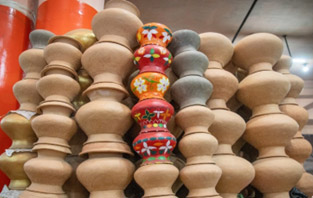
The residents of Thongjao Village in Thoubal District of Manipur are considered to be ancient pottery makers. They are believed to have migrated from Thongjaorok in Lamangdong, Bishnupur district 500 years ago. Pottery is a primary occupation of the village. It is mostly practiced by women without using a potter's wheel. The terracotta pottery is distinctive in form, craftsmanship and the creative use of reduction firing, rendering it a unique scarlet tan colour. Pottery is hand-formed using slabbing and shaping techniques. Red and black clay is mixed, kneaded, and rolled into a cylindrical form. A circular slab forms the base. The pot's neck and rim are shaped using fingers and a wet cloth. A wooden beater pats the outside, while an oval-shaped stone supports the inner layer. The surface is burnished with a seed, and the pots are baked in an open kiln.
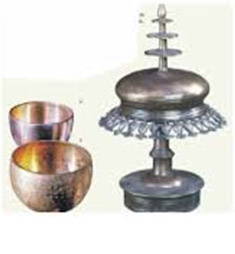
The Meiteis, a cluster of craftsmen, specialise in the lost wax casting of bell metal, a traditional craft for ceremonial and domestic purposes. Meiteis make a wide range of bell metal vessels for ceremonial and domestic uses of which the bowl chaisel and shentakal shenga, a dish with a lid for offering betelnut and leaves to God, are distinctive in form. Clay models surrounded by wax strands are filled with a molten alloy of copper and tin, creating a cavity left by the wax melting. The cast metal is then finished on a lathe and polished by hand, and then decorated using hand drills, engravings, or hammering and embossing. The bell metal ware, or senjeng, has a strong market in Manipur.
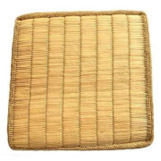
The kauna, a local reed found in marshes and stagnant water, is used to weave a unique textured mat with detailed edges. The weaver manually interlaces the cut start in pairs of jute threads, creating stiffness and bulk that forms the mat's texture. Extra lengths of the stem are intertwined at the edges to form a border. Square cushions are made by weaving two mats consecutively in the same warp and folding one mat over the other to form a double layer. These reed mats have been successfully exported, and 1000 craftspersons in Imphal Valley practice this craft, making square, circular, and rectangular mats.
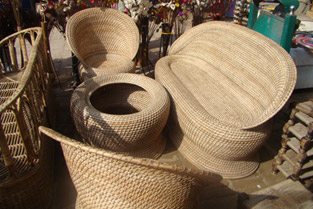
The Meitis of Manipur creates a variety of functional and ceremonial products, including baskets, trays, and containers used for offerings and gift enclosures during religious and wedding processions. These products are carried on the head according to local rites. The phingaruk is a basket with a dome-shaped lid decorated with vegetable-dyed strips, while the Long is a fishing basket made by deforming a flat mat into a dome-shaped container using bamboo rings. The Maring tribes in the hills behind Imphal Valley create a low dining table called leephang, made from bamboo splits, whole cane, and split cane binding. The splits are dyed in a plant dye from shaikui, a tree bark, and smoked to give the product a deep brown colour.
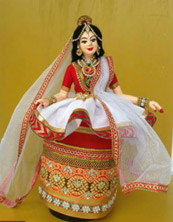
The doll-making craft of Manipur is called laiphadibi. It is made up of two words: lai, which means god and phadi, which means a shabby piece of cloth. The last syllabi, bi, denotes the feminine gender. So, laiphadibi is a feminine image of god, made from shabby clothes. These dolls are treated as living spirits and called ita, meaning female companion. Most older women make these cloth dolls through a ritual called boriba, which involves seeking permission and blessings by offering a nominal fee to the teacher. Various colourful materials are required for making laidhibi, including plain white cotton for the face, bright-coloured dress materials for the potloi, beads, sequins, cari fabric for the boswan, net or semi-transparent material for the veil, laces, and jewelry. Lord Krishna is one of the most popular cloth dolls representing local deities and dancing figures. However, this traditional craft is slowly fading in the face of digital and fast-paced machines and toys.
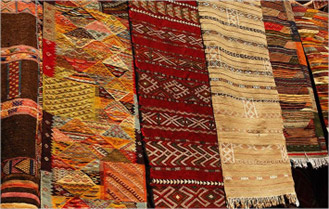
Manipuri textiles are characterised by legends, special functions, dances, and ceremonies. Ningthou phee and akoibi are based on snake motifs and the design is worn by royalty. Tradition has it that when a weaver used to sit down to weave the ningthou phee, the royal design, a gun salute would be fired in honour. A black shawl with thick, bold embroidered animal motifs is called the angami naga, it was given to brave and distinguished warriors by royalty. Shamilami is a combination of weaving and embroidery once considered a status symbol. The patterns in use here are typical of the region. Bold colours and geometrical patterns are in evidence in most of their textiles. Lasingphee, a quilted cotton material, is produced in Manipur and used as a winter covering. Colours are obtained from natural sources, with wild indigo juice used as a dye. Morangfi saris, woven in white or soft colours, carry a mandir shikhara (temple top) on the border with dotted patterns believed to be created by the Goddess Morangfi herself.
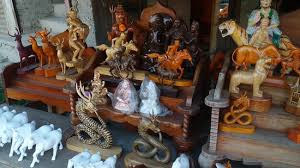
In Manipur, two types of wood, locally known as wang and heijuga, are used for wood-carving. Trees are cut when they reach full maturity and the logs are seasoned for a period of three to four months, in order to preserve the original colour of the wood. Wang wood is lightweight and does not crack easily, whereas heijuga wood needs to be seasoned properly before use or else it warps. The heijuga is weighty. The ancient traditional motifs of Manipuri culture are carved by the artisans. Lacquer work similar to that of Myanmar can also be found in Manipur. The resin is applied in a thickened or liquid state for ornamentation of swords, scabbards, sword handles, and leather belts.